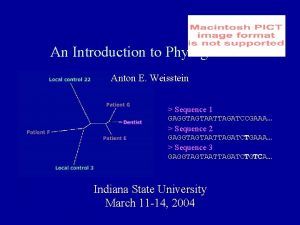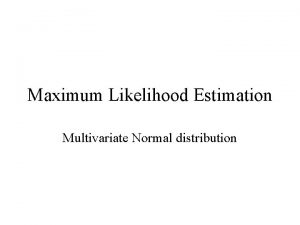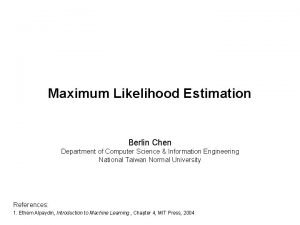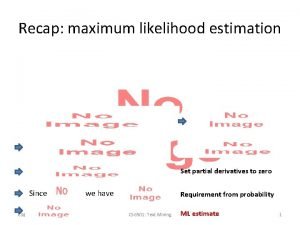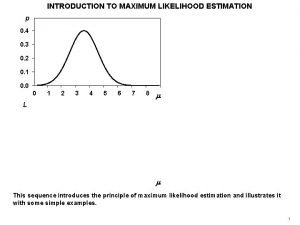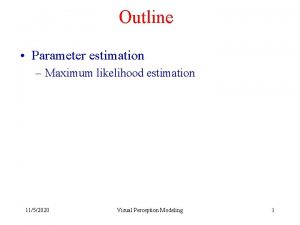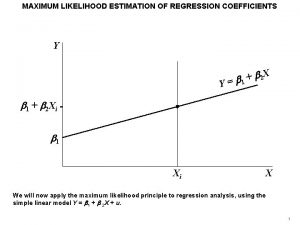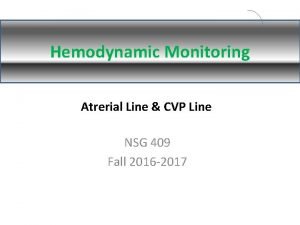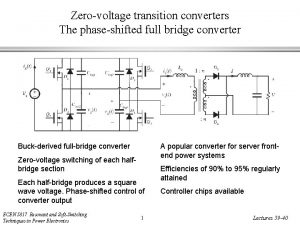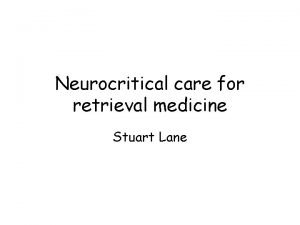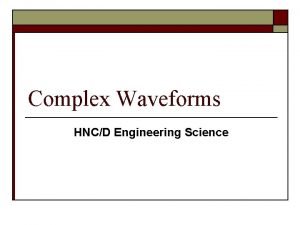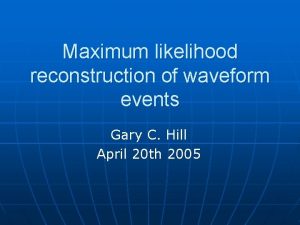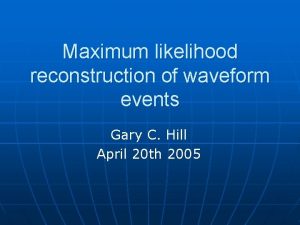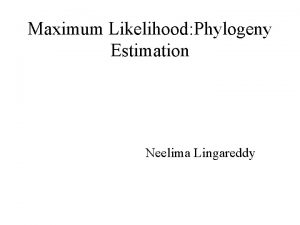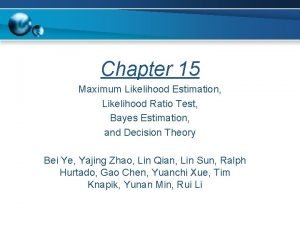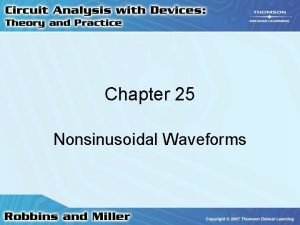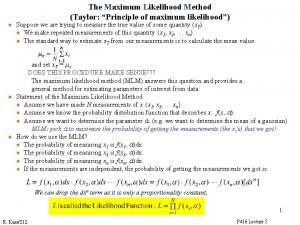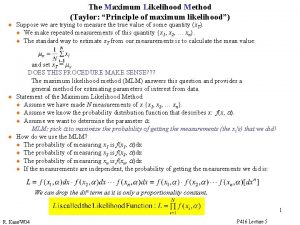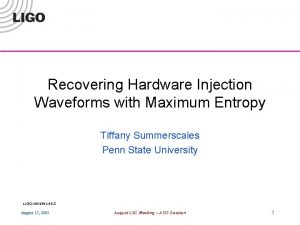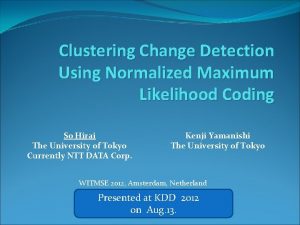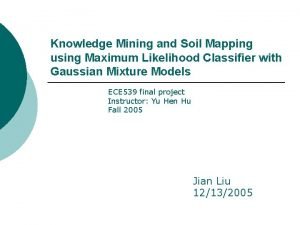Maximum likelihood reconstruction of events using waveforms Gary


















- Slides: 18

Maximum likelihood reconstruction of events using waveforms Gary Hill & Sean Grullon Ice. Cube Flasher & Cascade Analysis Workshop

Overview Ice. Cube Flasher & Cascade Analysis Workshop July 23 -27, 2005 Berkeley July 26 th 2005 • • Introduction & Motivation Likelihood Formulation wf-llh-reco project in Ice. Tray Preliminary Results using Simulation V 01 -00 -03 • Connections to other projects & future directions • Discussion Gary Hill & Sean Grullon 2

Introduction & Motivation Ice. Cube Flasher & Cascade Analysis Workshop • July 23 -27, 2005 Berkeley • • July 26 th 2005 All reconstruction algorithms in Ice. Rec are ported from AMANDA. – Were originally developed for the Muon-DAQ… (TOTs, LEs, Peak Amp. ) Need new algorithm(s) to take advantage of the full waveform information Icecube provides. A high priority since deployment has already begun. Gary Hill & Sean Grullon 3

Likelihood Formulation Ice. Cube Flasher & Cascade Analysis Workshop July 23 -27, 2005 Berkeley July 26 th 2005 • How can you formulate a likelihood function with the full waveform at your disposal? • Consider first the ideal case where the OM time response is a delta function • Ignore any possible amplitude fluctuations for the moment. • Given an expected distribution of photons μp(t), what is the probability of observing a waveform f(t)? – p(t) is normalized timing probability, μ is the total number of expected photons, given either numerically (Photonics) or analytically (e. g. Pandel) – f(t) is your observed waveform Gary Hill & Sean Grullon 4

Probability of f(t) given p(t)? Ice. Cube Flasher & Cascade Analysis Workshop • Suppose you bin the photon distributions into k bins: July 23 -27, 2005 Berkeley July 26 th 2005 Gary Hill & Sean Grullon 5

Probability of {ni } | {μi} ? Ice. Cube Flasher & Cascade Analysis Workshop • The probability is given by Poisson statistics, as a product of Poisson probabilities over all the k bins: July 23 -27, 2005 Berkeley July 26 th 2005 Gary Hill & Sean Grullon 6

This product turns into something useful…. Ice. Cube Flasher & Cascade Analysis Workshop July 23 -27, 2005 Berkeley July 26 th 2005 Gary Hill & Sean Grullon 7

Ice. Cube Flasher & Cascade Analysis Workshop July 23 -27, 2005 Berkeley July 26 th 2005 • … Namely a multinomial distribution, the probability of arranging exactly N events into k bins, multiplied by the Poisson probability of these N events occurring. Gary Hill & Sean Grullon 8

We have our Likelihood Function Ice. Cube Flasher & Cascade Analysis Workshop • Take the negative log of it July 23 -27, 2005 Berkeley July 26 th 2005 Gary Hill & Sean Grullon 9

Where is this applicable? Ice. Cube Flasher & Cascade Analysis Workshop July 23 -27, 2005 Berkeley July 26 th 2005 • We assumed we knew the photon arrival times precisely, or have a waveform made from the superposition of many photons. • If we have a non-delta function time response, this form is still applicable as long as our PDF is slowly varying over the region described by the OM time response. • Should be the case for our optical modules, typical pulse widths are narrow relative to the scale of expected photon arrival time distribution. Gary Hill & Sean Grullon 10

wf-llh-reco module Ice. Cube Flasher & Cascade Analysis Workshop July 23 -27, 2005 Berkeley July 26 th 2005 • The icetray implementation of this likelihood reconstruction. • Currently looking at (non-directional) cascades. • Uses UPandel for the timing PDF and PHit. PNo. Hit to get the expected PEs. • Uses the MIGRAD minimizer in ROOT’s TMinuit class. • Module in the sandbox area of SVN, named wf -llh-reco. Gary Hill & Sean Grullon 11

Preliminary Results using Simulation V 01 -00 -03 Ice. Cube Flasher & Cascade Analysis Workshop July 23 -27, 2005 Berkeley July 26 th 2005 • Newest version of Simulation metaproject just released over the weekend. • 500 100 -Ge. V cascade events were simulated with the vertex at the origin. • Three reconstruction modules compared in icetray: CFirst, cscd-llh and wf-llh-reco. Gary Hill & Sean Grullon 12

Preliminary Results Using Simulation V 01 -00 -03: Vertex X Ice. Cube Flasher & Cascade Analysis Workshop July 23 -27, 2005 Berkeley July 26 th 2005 Gary Hill & Sean Grullon 13

Preliminary Results using Simulation V 01 -00 -03: Vertex Y Ice. Cube Flasher & Cascade Analysis Workshop July 23 -27, 2005 Berkeley July 26 th 2005 Gary Hill & Sean Grullon 14

Preliminary Results using Simulation V 01 -00 -03: Vertex Z Ice. Cube Flasher & Cascade Analysis Workshop July 23 -27, 2005 Berkeley July 26 th 2005 Gary Hill & Sean Grullon 15

Preliminary Results using Simulation V 01 -00 -03: Vertex T Ice. Cube Flasher & Cascade Analysis Workshop July 23 -27, 2005 Berkeley July 26 th 2005 Gary Hill & Sean Grullon 16

Future Directions Ice. Cube Flasher & Cascade Analysis Workshop July 23 -27, 2005 Berkeley July 26 th 2005 • First and foremost, continue development and check the algorithm. • Incorporate Photonics as the “PDF of choice” for waveform reconstruction. • Look at other event types (directional cascades, muon tracks, high energy tracks, etc) • Optimize the minimization, perhaps use another minimizer? Gary Hill & Sean Grullon 17

Discussion Ice. Cube Flasher & Cascade Analysis Workshop July 23 -27, 2005 • Thoughts and Comments • Possible connection with other waveform based algorithms? Berkeley July 26 th 2005 Gary Hill & Sean Grullon 18
 Maximum likelihood vs maximum parsimony
Maximum likelihood vs maximum parsimony Maximum likelihood vs maximum parsimony
Maximum likelihood vs maximum parsimony Q1qp
Q1qp Maximum likelihood missing data
Maximum likelihood missing data Maximum likelihood
Maximum likelihood Maximum likelihood estimation
Maximum likelihood estimation Extended maximum likelihood
Extended maximum likelihood Maximum likelihood
Maximum likelihood Maximum likelihood estimator
Maximum likelihood estimator Maximum likelihood
Maximum likelihood Maximum liklihood
Maximum liklihood Maximum likelihood
Maximum likelihood Phlebostatic axis
Phlebostatic axis Buck converters
Buck converters Ac waveforms
Ac waveforms Single phase dual converter waveforms
Single phase dual converter waveforms Ventilator graphics
Ventilator graphics Icp waveform a b c
Icp waveform a b c Complex waveforms
Complex waveforms

